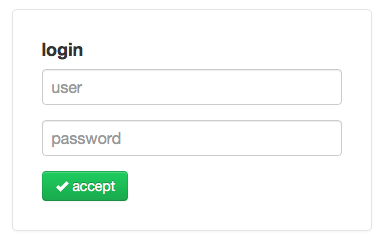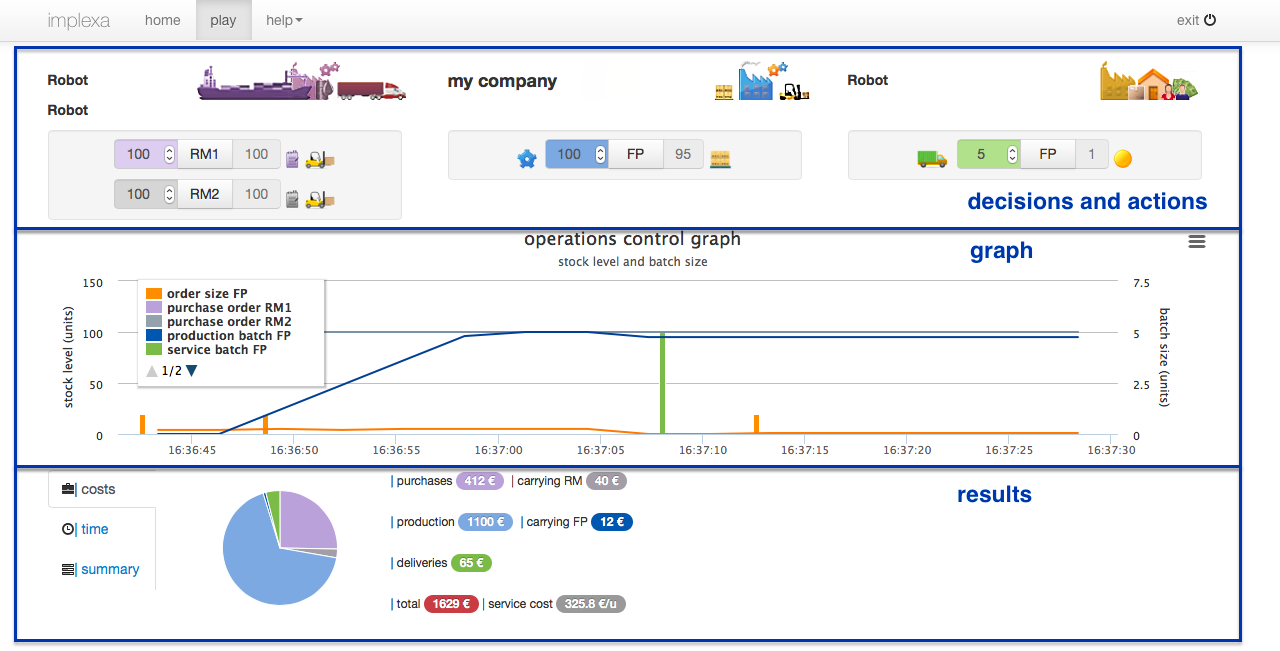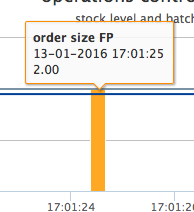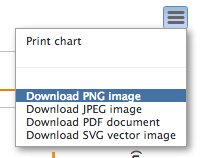help user manual
1 | user validation
 To play implexa, first you must log in as a user. Your teacher will tell you, what is your username and password. You have to enter in the identification box [login].
To play implexa, first you must log in as a user. Your teacher will tell you, what is your username and password. You have to enter in the identification box [login].
The game starts after logging correctly. You take the role of a company in the logistics supply chain. For example, a factory that should serve orders from end customers, or one of its suppliers (first-level), or perhaps one of the second-level suppliers, etc.
All play and the necessary information will appear in the action section [play], but before playing you should read all this help to better understand the user interface and how to play.
2 | knowing the user interface
The user interface is divided into three zones (decisions and actions, control graph and results).

- decisions and actions
The control panel is on top so you can make your decisions and actions. Divided into three columns, from left to right you will see: your suppliers, your company, and your client.

In each section you will find the name of the company (or Robot if handled automatically by the device). A cell colored to select the number of items (raw materials [RM1, RM2] or finished product [FP]). A button to execute the action (buy raw materials, processing, shipping finished product to the customer). A gray cell that reports the stock level of inventory (raw materials [RM1, RM2], finished product [FP]) or waiting demand (for your client).
With all the information you need to make decisions on 'when and how': buy, produce, stock and serve to cover the demand in the shortest time and minimun cost. You can not produce 1 unit of finished product if you don't have (at least) one unit of each raw material. And you can not serve your customer 1 unit, if it has not been requested, or if you do not have in finished product stock. Keep in mind that be a time delay between when you make the decision and the action until its result.
A set of animated icons represent your activity level (release orders, information flow and material flow).
- operations control graph
In the central part of the screen a graphic is displayed in real time (horizontal axis) with a set of variables. The vertical axis on the left shows inventory levels (raw materials and finished product) as well as the pending demand. The vertical axis on the right shows the batch sizes for raw materials purchases, production of finished product and delivery. The size of the orders are coming from our client also appears. Note the color of each data set, these are the same colors that are used in the action buttons and results.

The graph is interactive and has three interesting features: from the legend you can hide/show the series you like by clicking on its name. If you put your mouse over any point on the graph detailing the series and its value appears. From the menu on the right you can print the graph or export it to an image file (in different formats).



- results
At the bottom of the screen you will see three tabs (cost, time and summary), each of which gives you access to real-time game results. On the first tab you will see the costs, cumulative totals and their percentage by origin (purchasing, production, shipping and warehouse).

In times tab shows the (total lead-time), according to the total time required for customer service (including purchases, production and shipping). The time (seconds) is averaged by managed unit.

The last tab summary of your activity in the game: total game time, total units (purchased, manufactured, ordered and served), the percentage of satisfied demand, and average stock of each component and finished product.

3 | how to play
Your teacher will explain the objectives of the game (what your company should try to achieve), and also some rules to correctly play (players per team, maximum game time, the available information, the information that you can, or not, share with others players, etc.). Read on to learn how to play in more detail.
- real-time
 The game implexa is played in real time. This is not a turn-based game where the actions and decisions of the players happen more orderly one after another. In implexa everything happens quickly (no time to lose) and simultaneously (a bit chaotic)... as happens in real companies. As decided by the teacher can be a time scale, ie one minute of real time can be equivalent to a work day, a week, etc.
The game implexa is played in real time. This is not a turn-based game where the actions and decisions of the players happen more orderly one after another. In implexa everything happens quickly (no time to lose) and simultaneously (a bit chaotic)... as happens in real companies. As decided by the teacher can be a time scale, ie one minute of real time can be equivalent to a work day, a week, etc.- demand
 There are two types of demand: the independent demand is coming from the end customer market (consumer) will have its own nature: cyclical, trend, seasonality and uncertainty. It is unknown, although a teacher might give you some information in different rounds of the game so that you can make a forecast of demand. The dependent demand is the demand for components or raw materials coming from the requirements of the production plan. You need one unit of each item of raw material to produce one unit of finished product. Thus, the independent demand results in a dependent demand to suppliers. While the company that serves the customer must serve the independent demand, their provider will serve the dependent demand.
There are two types of demand: the independent demand is coming from the end customer market (consumer) will have its own nature: cyclical, trend, seasonality and uncertainty. It is unknown, although a teacher might give you some information in different rounds of the game so that you can make a forecast of demand. The dependent demand is the demand for components or raw materials coming from the requirements of the production plan. You need one unit of each item of raw material to produce one unit of finished product. Thus, the independent demand results in a dependent demand to suppliers. While the company that serves the customer must serve the independent demand, their provider will serve the dependent demand.- costs
 In the game are considered different types of costs. On the one hand there are variable costs that are determined from the amount of managed units (from raw material purchase, production, shipping and stock). On the other hand there are fixed costs that are independent of the units (purchase order, production order, dispatch). Finally, we must also take into account inventory costs (warehouse) for both raw materials to finished products. The costs are calculated in real time.
In the game are considered different types of costs. On the one hand there are variable costs that are determined from the amount of managed units (from raw material purchase, production, shipping and stock). On the other hand there are fixed costs that are independent of the units (purchase order, production order, dispatch). Finally, we must also take into account inventory costs (warehouse) for both raw materials to finished products. The costs are calculated in real time.- lead-times
 Although the game is played in real time, the result of your decisions and actions will not be instant. A time for your order arrives to your provider, to implement and manufacture a range of products, to transport the finished product to the customer, etc. are required. You must remember that these times (lead-time) will propagate through the chain (your provider will also need time to make and serve your orders) and this will cause a delay in the behavior of your actions.
Although the game is played in real time, the result of your decisions and actions will not be instant. A time for your order arrives to your provider, to implement and manufacture a range of products, to transport the finished product to the customer, etc. are required. You must remember that these times (lead-time) will propagate through the chain (your provider will also need time to make and serve your orders) and this will cause a delay in the behavior of your actions.- other considerations
 There are other considerations you should keep in mind. In the game there is a limit of production capacity per unit time. Although you can produce a large quantity, larger batches require more production time, will take longer to be complete the order and have it available in the warehouse for distribution. On the other hand, there is no limit on storage capacity so you can store the amount you want. There is no financial constraint. You can buy and own as many products as you want. No limit on the costs that you may incur. The teacher will ask you about the results of your actions and profitability.
There are other considerations you should keep in mind. In the game there is a limit of production capacity per unit time. Although you can produce a large quantity, larger batches require more production time, will take longer to be complete the order and have it available in the warehouse for distribution. On the other hand, there is no limit on storage capacity so you can store the amount you want. There is no financial constraint. You can buy and own as many products as you want. No limit on the costs that you may incur. The teacher will ask you about the results of your actions and profitability.